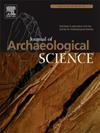清理死者:优化去污增强了对塔吉克斯坦Khudji的更新世古人类牙齿的古蛋白质组学分析
IF 2.6
1区 地球科学
Q1 ANTHROPOLOGY
引用次数: 0
摘要
对保存在一系列考古、文化遗产和古生物材料中的古代蛋白质的研究日益有助于我们对人类进化和考古研究问题的理解。许多被研究的标本在进行蛋白质组学分析之前已经被挖掘和储存了很长时间。因此,人类处理和储存环境为蛋白质污染和进入古蛋白质组学研究感兴趣的标本提供了充足的机会。因此,现代蛋白质污染限制了内源性蛋白质组的获取。在这里,我们比较了五种方法的骨蛋白净化应用于一个被现代狗蛋白质组污染的更新世马属的骨碎片。我们发现所有的测试方法都能减少蛋白质污染,但效率不同。我们发现短暂的漂白剂洗涤是去除现代蛋白质污染的最有效方法,并且这种处理不会对内源性蛋白质组造成额外的损害。接下来,我们将这种方法应用于在塔吉克斯坦晚更新世考古遗址Khudji发现的一颗古人类牙齿。我们证明,短暂的漂白剂洗涤去除几乎所有的人类皮肤蛋白质污染,同时保留内源性人类牙本质蛋白质组。随后对Khudji牙本质蛋白质组的系统发育分析表明,该标本可能代表尼安德特人,扩大了尼安德特人在中亚的化石证据。本文章由计算机程序翻译,如有差异,请以英文原文为准。
Cleaning the dead: Optimized decontamination enhances palaeoproteomic analyses of a Pleistocene hominin tooth from Khudji, Tajikistan
The study of ancient proteins preserved in a range of archaeological, cultural heritage, and palaeontological materials is increasingly contributing to our understanding of human evolution and archaeological research questions. Many of the specimens studied have been excavated and stored for a significant duration prior to their proteomic analysis. Human handling and storage environments therefore provide ample opportunities for protein contamination onto and into specimens of interest to palaeoproteomic studies. As such, modern protein contamination limits access to endogenous proteomes. Here, we compare five approaches of bone protein decontamination applied to a Pleistocene Equus sp. bone fragment contaminated with a modern dog proteome. We find that all tested methods reduce the protein contamination, but with different efficiencies. We find that a brief bleach wash is the most effective approach in removing modern protein contamination, and that no additional damage is caused to the endogenous proteome by this treatment. Next, we apply this approach to a hominin tooth found at Khudji, a Late Pleistocene archaeological site in Tajikistan. We demonstrate that a brief bleach wash removes almost all human skin protein contamination while retaining the endogenous hominin dentine proteome. Subsequent phylogenetic analysis of the Khudji dentine proteome allowed determination that the specimen likely represents a Neanderthal, extending the fossil evidence for Neanderthals in Central Asia.
求助全文
通过发布文献求助,成功后即可免费获取论文全文。
去求助
来源期刊

Journal of Archaeological Science
地学-地球科学综合
CiteScore
6.10
自引率
7.10%
发文量
112
审稿时长
49 days
期刊介绍:
The Journal of Archaeological Science is aimed at archaeologists and scientists with particular interests in advancing the development and application of scientific techniques and methodologies to all areas of archaeology. This established monthly journal publishes focus articles, original research papers and major review articles, of wide archaeological significance. The journal provides an international forum for archaeologists and scientists from widely different scientific backgrounds who share a common interest in developing and applying scientific methods to inform major debates through improving the quality and reliability of scientific information derived from archaeological research.
 求助内容:
求助内容: 应助结果提醒方式:
应助结果提醒方式:


